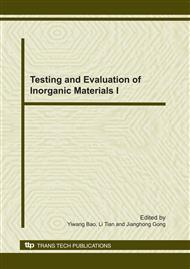p.249
p.253
p.257
p.260
p.264
p.269
p.272
p.277
p.281
Preparation of Rare-Earth Permanent Magnetic Strontium Ferrite by Microwave Sintering Process
Abstract:
In this paper, the green body was prepared by pre-roasted material of strontium ferrite, adding 0.2 to 9% the rare earth additive, by wet milling and forming into pellets Φ30×10 mm under magnetic field. Then, the green body was sintered separately by microwave sintering (MS) method and conventional sintering (CS) technique. The results showed that: the strontium ferrite samples with the same magnetic properties Br and (BH) max were 420 ± 10mT and 33.0 ± 2 kJ/m 3) were synthesized by microwave sintering (MS) method against conventional sintering method, the sintering temperature and time were reduced 150~300°C and 5~6h. Therefore, microwave sintering method will significantly decrease energy consumption. Further analysis revealed that the major improvements in microwave sintering were the material microstructure, the grain size was significantly reduced, the magnetic domain short-range order was increased so that the degree of orientation was increased, and although the fusion was existed between grains, the grain boundaries did not disappear.
Info:
Periodical:
Pages:
264-268
Citation:
Online since:
December 2010
Authors:
Price:
Сopyright:
© 2011 Trans Tech Publications Ltd. All Rights Reserved
Share:
Citation:


